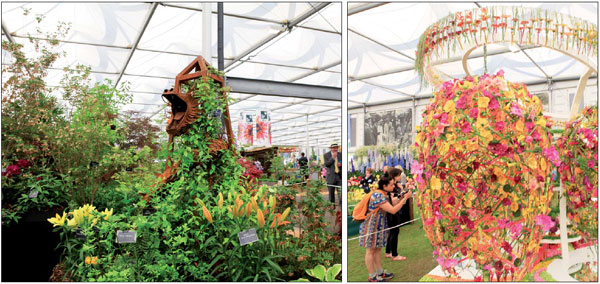British to the very roots? Not quite

| Left: Chelsea Flower Show exhibits a China themed stand for the first time in London. Right: A display attracts close attention. Zhang Chunyan / China Daily |

Glorious gardens hold a secret. look closely at the dna and you may spot a sign saying 'made in China'
Many visitors to the world-famous Chelsea Flower Show will be surprised to learn that some of the flowers in their gardens at home that they think of as being British to the roots in fact originated in China.
The Chinese plants, including lilies, hydrangeas and peonies, now commonly seen in many English gardens, were brought to Britain by plant hunters in the 19th century.
The 101st Chelsea Flower Show, staged by the Royal Horticultural Society in central London and held over five days from May 20, has given the public the chance to learn something about these plants and their journey from the Far East. The Chelsea event is one of the biggest flower shows anywhere, with more than 500 exhibitors, and attracting visitors from around the globe.
The history of the flowers of Chinese origin was part of a display by Burncoose Nurseries of Cornwall, which, reflecting the Chelsea show's vintage, has 101 Chinese plants.
Charles Williams, owner of Burncoose Nurseries, says his great-grandfather J. C. Williams greatly contributed to China's export of flower seeds to Britain by sponsoring plant hunters on their expeditions to collect seeds.
The hunters collected seeds in remote regions of China, wrapped them in wax, brought them back to Britain by ship, and grew them in Cornwall. They also brought back pressed flowers so each species could be identified in official records.
The 101 plants exhibited represented the works of early plant hunters including Ernest Wilson (1876-1930), George Forrest (1873-1932) and Frank Kingdom Ward (1885-1958). A collection of photos taken on some of Forrest's 11 expeditions to China between 1905 and 1932 are on display at the Burncoose stand, illustrating the adventures the plant hunters experienced and the challenges they faced.
The photographs, on public display for the first time, are from the Williams family archive on the Caerhays Estate in St. Austell, of which Burncoose Nurseries is a part.
The Caerhays Estate has many flowers that were brought back from China in J. C. Williams' day. Williams hopes the gardens' connection with China will attract more Chinese visitors. The Caerhays gardens are open to the public for more than 100 days from mid-February to early June and attract more than 14,000 visitors a year.
Transporting the flowers from Cornwall to London for the Chelsea Flower Show required weeks of preparation, Williams says. They were put into cold storage, which kept them from blooming, to ensure they would blossom and reach peak condition during the show.
The Burncoose stand was sponsored by Terra Firma Capital Partners, a private equity firm that is also a supporter of the charity The Prince's Trust, and uses its sponsorship of the Chelsea Flower Show to support the work of the charity.
Guy Hands, chairman and chief investment officer of Terra Firma, says he hopes those who see such displays realize how many of the plants in England came from other parts of the world, including China.
"And also it would help encourage people visiting China to not just see the Great Wall, but also see many of the gardens in China."
In the 18th century, gardening was becoming increasingly popular in Britain, and as a result, demand for rare and exotic plants from different parts of the world, especially China and South America grew, Hands says.
Even so, these plant-hunting expeditions were rare because each journey would require years of travel. Trips to remote places would put the hunters in great physical danger, especially because some of the flowers could cause them injury, and it was difficult to get medical help in remote areas.
"It wasn't safe," Hands says. "In remote places there was the risk of falling down. There were stories of plant hunters caught in quicksand who were sucked in and drowned. Others would find a rare orchid, but cut themselves and became infected. They very much had to look after themselves."
Having faced the dangers they did, the plant hunters became celebrities when they returned to England, Hands says.
"People wanted to listen to their speeches and see their plants.
Many plants sent from China to Britain survived well because many of the soils of both China and the UK are acidic. Many of the plants shown at the Burncoose stand were from Sichuan and Yunnan provinces. Thanks to a strong gardening culture in Britain, these plants have become an intrinsic part of British society.
One reason for the popularity of gardening in Britain was the country's poor weather, which meant people took an extra interest in gardening when the sun was out, Hands says.
"When they had a few days to do it, they took it seriously."
Nowadays, since British gardening is so well known and more Chinese people are interested in gardening art, Hands says, there is a good opportunity for exchanges between the two countries.
With gardening, the British may well lead the world, he says.
"We do enormous amounts of garden art. So it's a good opportunity both in terms of us sourcing things in China and also Chinese sourcing things in the UK."
It is a good way to promote bilateral trade, Hands says. Hopefully Chinese tourists will come to England and enjoy its gardens, and English tourists will go to China and admire its gardens, he says
"We are really focusing on that. So hopefully the garden center will do trade with China."
Contact the writers at cecily.liu@chinadaily.com.cn and zhangchunyan@chinadaily.com.cn
(China Daily European Weekly 05/23/2014 page28)
Today's Top News
- Takaichi must stop rubbing salt in wounds, retract Taiwan remarks
- Millions vie for civil service jobs
- Chinese landmark trade corridor handles over 5m TEUs
- China holds first national civil service exam since raising eligibility age cap
- Xi's article on CPC self-reform to be published
- Xi stresses improving long-term mechanisms for cyberspace governance































